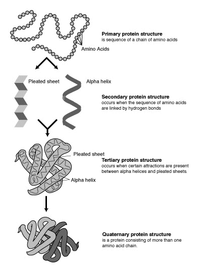
Photo from wikipedia
Protein secondary structure, solvent accessibility and torsion angle predictions are preliminary steps to predict 3D structure of a protein. Deep learning approaches have achieved significant improvements in predicting various features… Click to show full abstract
Protein secondary structure, solvent accessibility and torsion angle predictions are preliminary steps to predict 3D structure of a protein. Deep learning approaches have achieved significant improvements in predicting various features of protein structure. In this study, IGPRED-Multitask, a deep learning model with multi task learning architecture based on deep inception network, graph convolutional network and a bidirectional long short-term memory is proposed. Moreover, hyper-parameters of the model are fine-tuned using Bayesian optimization, which is faster and more effective than grid search. The same benchmark test data sets as in the OPUS-TASS paper including TEST2016, TEST2018, CASP12, CASP13, CASPFM, HARD68, CAMEO93, CAMEO93_HARD, as well as the train and validation sets, are used for fair comparison with the literature. Statistically significant improvements are observed in secondary structure prediction on 4 datasets, in phi angle prediction on 2 datasets and in psi angel prediction on 3 datasets compared to the state-of-the-art methods. For solvent accessibility prediction, TEST2016 and TEST2018 datasets are used only to assess the performance of the proposed model.
Journal Title: IEEE/ACM Transactions on Computational Biology and Bioinformatics
Year Published: 2022
Link to full text (if available)
Share on Social Media: Sign Up to like & get
recommendations!